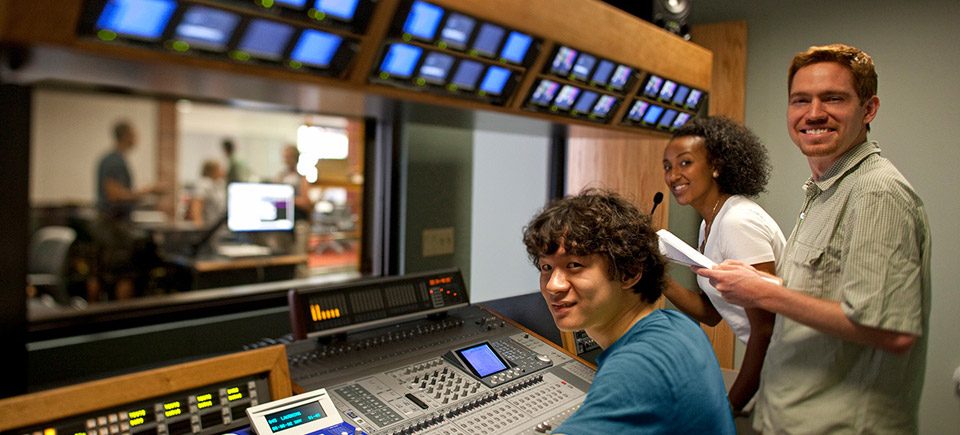The Donald W. Reynolds School of Journalism and Center for Advanced Media Studies welcomes students and faculty to campus this fall after renovations and a rededication catapult the school into the digital age.
"I think the renovations will be incredibly beneficial for incoming students and will ensure that the Reynolds School of Journalism remains one of the top journalism programs in the country," said Jade Sheldon, a journalism major with an emphasis in public relations. "We already have incredible professors who mold the students into professionals and it's great that we now have a building with technology to aid these professors in their students' growth."
Sheldon, president of the School's Journalism Student Advisory Council last year and current strategic communications and outreach intern for Planned Parenthood Mar Monte in Reno, said she enjoys the latest technologies, including new wiring and projection screens in all classrooms, new computers in newly configured spaces, video screens, and the other features such as glass walls and new furniture. Students, staff and faculty were able to move back into the building in the spring while some finishing touches were still being completed, after more than a year of construction.
The building's renovation was supported by a $7.9 million gift from the Donald W. Reynolds Foundation, and a $1.6 million Fund for the Future of Journalism campaign, which will support the building and technology enhancements. The building opened in 1992, and the recent gift by the Donald W. Reynolds Foundation continues a tradition of substantial contributions to the School by the Foundation since the early 1980s.
At a rededication ceremony at the School attended by about 150 friends and supporters on Aug. 21, University President Marc Johnson and Reynolds School of Journalism Dean Alan Stavitsky recognized the contributions of the Donald W. Reynolds Foundation, along with the contributions of other major supporters including the Scripps family, the John Ben Snow Memorial Trust and the University of Nevada, Reno Foundation.
"It has always been our desire that this school of journalism which bears Mr. Reynolds name would provide a first-class educational experience that is relevant to the industry for the students enrolled in the program," stated Donald W. Reynolds Foundation Chairman Fred W. Smith at the rededication ceremony.
Over the past 18 months, the building has undergone substantial improvements that enhance the School's multimedia, broadcast and digital technology capabilities, while retaining the building's warm, traditional characteristics. The new technological infrastructure further strengthens the School's ability to educate multiplatform professionals trained in the essentials and ethics of journalism and strategic communication.
"We now have the best of both worlds," said Reynolds School of Journalism Dean Al Stavitsky. "Not only did the building improvements create more public spaces for interaction to enhance our School's wonderful sense of community, but we also now have the leading-edge technology our students need to innovate and to succeed in this digital age."
The improvements in technology are evident as soon as you enter the building, with a huge, high-definition video screen that has replaced the large, old printing press in the Atrium. Nearby is a new, interactive, touch-screen information kiosk, with retrievable maps, directory information, class photos and alumni features. A new showcase provides a place to exhibit projects and awards of the school's students and alumni, such as the six Pulitzer Prizes garnered by alumni.
Just off the Atrium is the new Graduate Studies Suite, in a room once planned to house a dark room for photograph development. It is equipped with three flat-screen video screens, computers, a floor-to-ceiling whiteboard for group collaboration, student lockers and more. The Travis B. Linn Reading Room, just across the hall, still has the warmth of its brick walls and hearth, with laptop connection for collaborative work.
Perhaps at the center of the remodel is the Multimedia Newsroom, along with the accompanying Audio Control Room, Audio Studio and Clarence and Martha Jones Production Control. In the Newsroom, an anchor desk, studio lighting, a ceiling-mounted sky camera, edit bays and workstations allow students to work together in a connected environment very similar to many media newsrooms today. In fact, the Newsroom will allow the students to use Associated Press systems for workflow and news management.
"Students will produce news for print, online and broadcast from this room because that's journalism today," said Rosemary McCarthy, assistant professor at the School who also assumed the role of managing the massive remodel. "Our students must be prepared to work across media now - the lines are blurred, and this renovation accommodates and reflects that."
The Audio Studio can also serve as a video-editing area and can connect with an adjacent room for "town hall meeting" broadcast segments. The Broadcast Systems Room serves as an audio-visual hub with computers and specialized systems for controlling the newly added digital screens in the public areas and supporting the new screens in the conference rooms, labs and classrooms. It also serves as the broadcast system hub, from which television cameras, teleprompters, microphones and recorders throughout the building are driven.
"These rooms and technologies won't just be used by broadcast and news journalists," explained McCarthy. "They will also be used by students practicing pitches for public relations, advertising and marketing presentations. They will be able to tape their presentations and watch and critique themselves, and they need to be able to use this technology in their fields as well."
The renovations also clearly encourage "high-touch," as well as "high tech." Comfortable chairs, benches and cubes have been scattered throughout the building's hallways and nooks to create more places for students to gather. Lighter, more movable furniture has replaced older, bulkier fixtures in order to accommodate more flexible room set-up, a greater number of students and more group work. New, large screens, projector systems, podiums and large, floor-to-ceiling dry-erase whiteboards further facilitate active learning and group work.












